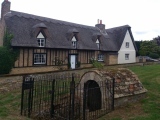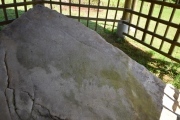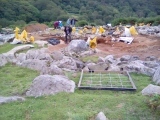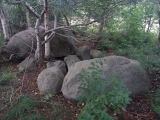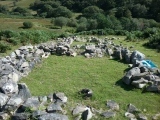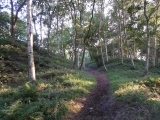Andy Burnham's Blog, page 161
September 8, 2021
Achnabreck
We have linked videos of several recent online rock art presentations in the comments on this page. There are three cup-and-ring marked outcrop rocks at this largest and most extensive group of prehistoric rockcarvings in Scotland. The site also boasts the largest cup-and-ring mark in Scotland. With its radial grooves it looks like a giant spider web over 1m in diameter.
Published on September 08, 2021 00:38
September 5, 2021
St Michael's Well (Cambridge)
Lying in the churchyard of the thatched chapel of St Michael, Longstanton near Cambridge, is a particularly fine example of a baptismal well. It is named just Holy Well or St Michael's Well. The well settles under a large tree in the corner of the tree which may be significant and is enclosed in a yellow brick half barrel well house, at the back of this is a cross shaped window.
Published on September 05, 2021 14:21
Tomori carving
In a valley distant from human residences in Kyūshū, Japan, there are three big flat stones with engravings representing bows, arrows, ships and so on. Two of them are preserved under shelters and the rest were buried back into the soil. They are hard to see in the photo but there is a diagram interpreting the carvings on our page.
Published on September 05, 2021 01:01
September 4, 2021
Cistfaen Llys Dorfil
Cymdeithas Archeoleg Bro Ffestiniog Archaeology Society have been excavating at a site within the Cwm Bowydd valley since 2018. This is a complex site consisting of multiple periods of occupation. However, for the purpose of this post I am highlighting a particular monument discovered by the Society during their excavations, i.e. a probable Cist Burial.
Published on September 04, 2021 07:59
Alsted Skov Langdysse 3
A long barrow deep in the forest in Sjælland, Denmark. It is 28m long by 14m wide, still 2m high and has 23 kerbstones. There is no chamber visible.
Published on September 04, 2021 02:26
September 3, 2021
Wanna Steingrab (3)
A chambered tomb in Lower Saxony that originally had 4 capstones. One capstone is missing now, and another is broken. Most of the uprights are preserved. Size approximately 5m x 1,8m. The chamber became overgrown by the bog in historic times. Today there is a thick wood without any path but lots of blackberry bushes. Wanna Tomb II and IV are nearby. (see the nearby sites list below on our page)
Published on September 03, 2021 12:28
Llys Dorfil
Currently under excavation (Aug 2021) by Cymdeithas Archaeoleg Bro Ffestiniog Archaeology Society, the site has been investigated since 2018. This is a complex site that appears to contain multi-period monuments, i.e. a cist burial dating from the bronze age, a round house, a large enclosed homestead dating from the medieval period to the 18th cent and more modern artefacts. Finds include flint, a ring dating from the medieval period and 18th cent pottery. Bones have also been discovered within the vicinity of the cist burial.
Published on September 03, 2021 10:24
September 2, 2021
Nordy Bank
A small hillfort but with well preserved banks and ditches and in a fantastic and beautiful setting make this a very worthwhile visit. Top photo: An orthomosaic of over 500 drone photos taken over Nordy Bank in late autumn 2019. Flights undertaken with permission from the parish Council.
Published on September 02, 2021 02:00
September 1, 2021
Tamnyrankin
The Northern Ireland Infrastructure minister has approved a huge 500ft wind farm on this neolithic landscape in Derry. This is despite refusal by the NI Environmental Agency, who classed it as having an unacceptable impact upon the integrity of the setting of this and the nearby Knockoneill portal tombs. A beautifully preserved court tomb in Co. Derry, one of the finest in Northern Ireland. The curved forecourt is intact and much of the covering cairn (which is about 90 feet in length) survives. The forecourt entrance leads to a double chamber, and there is also a horizontal gallery at the rear of the monument. The kerb stones which retain the cairn are visible along the edges of the monument.
Published on September 01, 2021 05:44
Pipinsburg
The Pipinsburg was a hillfort located on the north bank of the Sieverner Aue inland waterway. Unfortunately only the sand ramparts have survived to the present day. The location at the entrance to an inland waterway corresponds to the order of Charlemagne and his successors to secure the coast of Saxony against the Vikings, but evidence that the structure dates from Carolingian times has not yet been found.
Published on September 01, 2021 01:04


